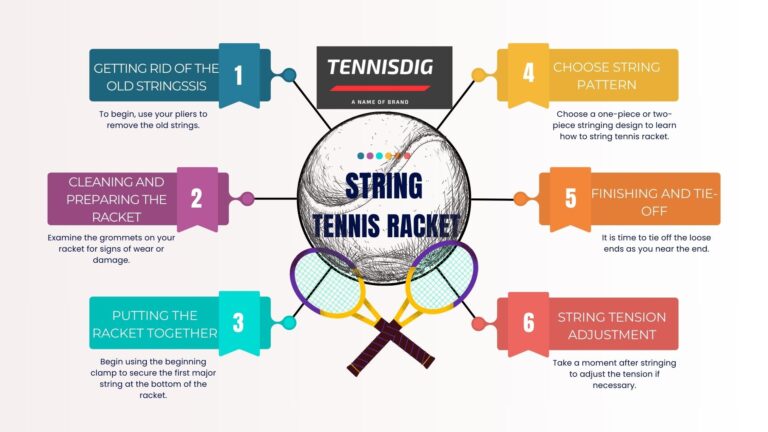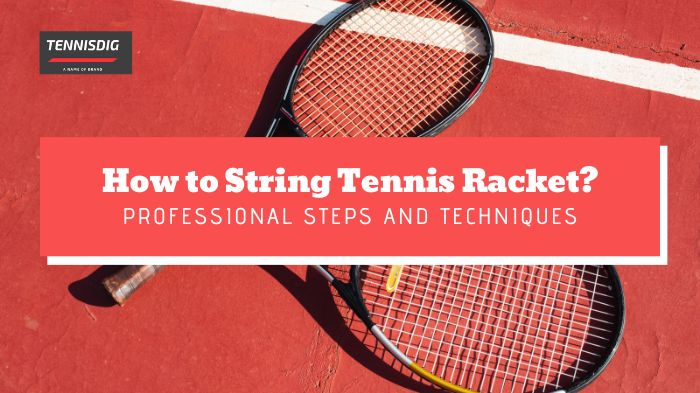Stringing a tennis racket is a job just for pros. However, with the appropriate instruction and a little patience, any tennis lover can learn and master how to string tennis racket.
Whether you’re an experienced player or just starting, understanding how to string tennis racket may make or break your game. Let’s go into the specifics of this remarkable talent.
What is String Tension?
Before learning how to string tennis racket, it is critical to comprehend string tension. The tension with which you string your racket is crucial to your playing style.
Higher tension gives you more control but less power, whereas lower tension gives you more power but less control. Finding the perfect balance is essential for improving your gaming.
How to String Tennis Racket?
Gather the instruments before beginning: a stringing machine, a pair of strings, pliers, scissors, an awl, a starting clamp, and a racket. To retain attention during the process, ensure your desk is clean, well-lit, and without distractions.

Getting Rid of the Old Strings
To begin, use your pliers to remove the old strings. Work your way around the racket, untying and cutting the strings. Make a mental note of the pattern in which the strings are weaved; this will come in handy throughout the restringing procedure.
Cleaning and Preparing the Racket
Examine the grommets on your racket for signs of wear or damage. Remove residual string bits or dirt from the grommet holes using an awl. This process guarantees smooth string movement while playing.
Putting the Racket Together
Begin using the beginning clamp to secure the first major string at the bottom of the racket. Follow your racket’s pattern, alternating between mains and crosses. Maintaining consistent tension throughout ensures the strings are snug but not too tight.
Choose String Pattern
Choose a one-piece or two-piece stringing design to learn how to string tennis racket. Any racket can be strung in one of two ways, with a single piece of string used for horizontal and vertical stringing or a separate piece for each.
Specific tennis players believe that using a single piece of string extends the life of the set and the racquet. However, appropriate technique on distinctive rackets makes using two pieces preferable.
String the cross strings from the end of the racquet (head) to the bottom of the racquet’s face, near the handle (throat). This is because string strain can significantly deform the racquet. As the neck is softer than the head, it is best to start at the top and move down. This is tough with a single piece of string and impossible with some racquets.
Finishing and Tie-Off
It is time to tie off the loose ends as you near the end. Use an appropriate knot to bind the strings while maintaining tension. Once the strings are in place, gently trim any extra with scissors.
String Tension Adjustment
Take a moment after stringing to adjust the tension if necessary. To improve the consistency of the racket, use a tension-calibrated device to ensure uniformity across all strings.
Racket Experiment
Now that the racket is strung, it is time for the most exciting part: putting it to the test on the court! Consider the feel, power, and control of your shots. Tension may be adjusted based on your playing experience.
Maintenance Suggestions
Maintaining your racket properly once it has been strung is critical for its durability. To guarantee the best performance, keep it in a temperature-controlled environment, examine the grommets regularly, and rest them regularly.
The Bottom Line
Stringing your tennis racket is a technique that may help you improve your game. To master the art, you must pay attention to detail, be patient, and practice consistently. Whether you play competitively or for fun, understanding how to string tennis racket offers a deeper connection to your equipment. It may greatly improve your performance on the court.
Please be mindful that practice and experience are the best teachers for learning the skill of stringing a tennis racket. So, gather your materials, take your time, and enjoy improving your game, one string at a time!

